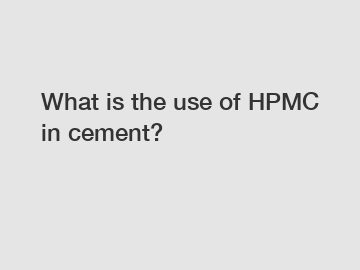What is the use of HPMC in cement?
Cement, the fundamental building block of construction, holds remarkable power in shaping and defining our physical world. However, the value of cement can be significantly enhanced through the incorporation of certain additives. In recent years, one such additive - Hydroxypropyl Methylcellulose (HPMC) - has emerged as a game-changer, revolutionizing the cement industry. Let's explore how HPMC brings a myriad of benefits to cement and why it has become an indispensable ingredient in modern construction.
Enhancing Workability and Water Retention.
HPMC is a hydrophilic compound that exhibits excellent water retention properties. When added to cement, it effectively increases workability without compromising the water content. This unique feature allows contractors and builders to have more control over the consistency and application of cement. As a result, HPMC aids in achieving better workability, reducing the occurrence of cracks, and ensuring a uniform finish on surfaces.

Improving Setting Time and Strength Development.
The setting time of cement plays a crucial role in construction activities. HPMC significantly affects the hydration process, ultimately enhancing the setting time of cement. By extending the initial curing period, HPMC allows more adequate time for hydration and reaction between cement particles. This leads to improved strength development, resulting in a more durable and long-lasting final product.
Reducing Shrinkage and Cracking.
One of the most common challenges in cement-based applications is the occurrence of shrinkage and cracking. HPMC effectively mitigates this problem by reducing the drying shrinkage of cement. During hydration, HPMC forms a protective film around cement particles, preventing excessive water evaporation and minimizing the occurrence of cracks. This enhanced resistance to shrinkage significantly improves the overall durability and structural integrity of cement-based constructions.
Enhancing Bonding Strength and Adhesion.
Effective adhesion is of paramount importance in many construction projects. HPMC enhances the bond between cement and various substrates, boosting the adhesion strength. Whether it's bonding ceramic tiles to walls or securing insulation panels, the addition of HPMC in cement-based adhesives promotes excellent adhesion properties. This ensures reliable and long-lasting connections, making it ideal for both interior and exterior applications.
Introducing Self-Leveling and Self-Healing Capabilities.
HPMC also brings incredible self-leveling properties to cement mixtures, making it highly suitable for applications where a level surface is crucial, such as flooring or leveling compounds. With its unique ability to disperse evenly, HPMC enables a smooth and seamless surface, eliminating the need for tedious manual leveling.
Moreover, HPMC can aid in achieving self-healing properties in cement-based materials. By filling and sealing microcracks that develop over time due to external factors or heavy loads, HPMC improves the concrete's structural integrity and reduces maintenance requirements. This makes HPMC a valuable ingredient for infrastructural projects with high-performance demands.
Additionally, HPMC acts as a rheology modifier, controlling the flow and rheological behavior of cement. Its presence prevents segregation and sedimentation, ensuring a homogenous mixture, even when transporting and pouring cement over long distances. This quality is particularly vital in large-scale construction projects.
Sustainable and Environmentally Friendly Solution.
In an era focused on sustainability, HPMC has emerged as an environmentally friendly solution, promoting the use of green products. The manufacturing process of HPMC involves high-quality natural cellulose, derived from renewable resources like wood. HPMC-based cement formulations minimize the environmental impact without compromising performance, thus reducing the carbon footprint of construction projects.
Conclusion.
The versatility and numerous advantages of HPMC in cement make it an indispensable ingredient for modern construction. From improving workability and water retention to reducing shrinkage and cracking, HPMC offers an array of benefits that enhance the overall performance and durability of cement-based applications. Its self-leveling and self-healing properties further solidify its irreplaceable role in construction projects. Furthermore, HPMC stands as a sustainable alternative, aligning with the global shift towards eco-conscious practices.
As the cement industry continues to evolve, HPMC remains at the forefront as a pivotal additive, elevating the standards of construction. Its impact is undeniable, and its potential is boundless, bringing us closer to stronger, more sustainable, and resilient built environments.
Want more information on hydroxypropyl methylcellulose powder, hpmc powder factory, pp fibers? Feel free to contact us.
157
0
0


Comments
All Comments (0)